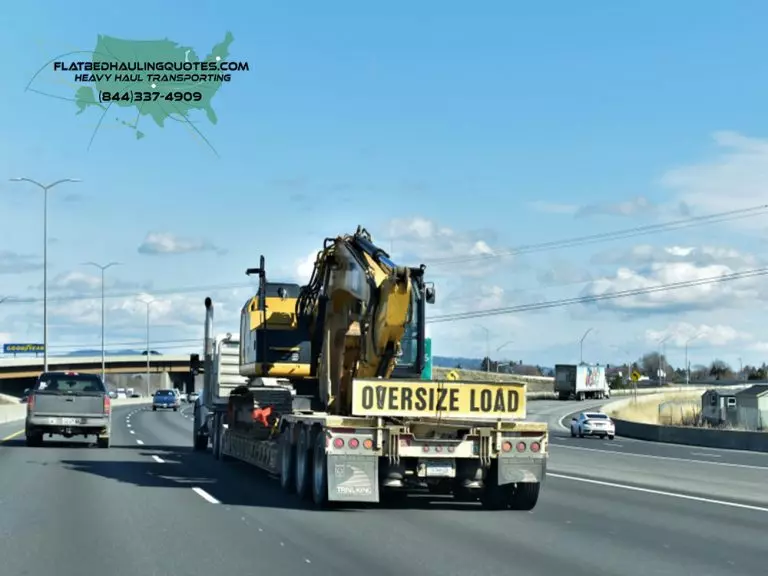How to Overcome Common Challenges in Heavy Equipment Freight?
Heavy equipment is an essential component of modern construction, mining, agriculture, and infrastructure projects. From bulldozers and excavators to cranes and harvesters, heavy equipment plays a critical role in achieving project outcomes. However, transporting heavy equipment is not an easy task due to its size, weight, and shape. We will provide you with a comprehensive guide to heavy equipment freight, including different types of equipment, challenges, preparation, and safety considerations. We will also explore the role of flatbed shipping companies, heavy haulers, and trucking companies in heavy equipment transportation.

Types of Heavy Equipment that May Require flatbed heavy haul Transportation
Heavy equipment can refer to various machinery used in different industries. The following is a list of typical heavy equipment that may require freight transportation:
– Bulldozers: They are massive machines with a front-mounted blade used for moving and removing earth materials, debris, and other obstacles from the construction site.
– Excavators: They are versatile machines that can dig ditches, trenches, and holes, move materials, and demolish buildings.
– Cranes: They are used for lifting heavy materials, equipment, and structures to great heights. Cranes are commonly used in construction, mining, and bridge building.
– Backhoes: They are similar to excavators, but they have a scoop at the back that can move soils and debris.
– Loaders: They are used for loading materials, such as dirt, sand, gravel, and rocks, onto trucks for transport.
– Forklifts: They are used for lifting and transporting heavy loads, such as containers, pallets, and raw materials, within warehouses and factories.
– Pavers: They are used for laying asphalt or concrete on roads, highways, and runways.
– Graders: They are used for flattening and leveling the surface of the earth, such as roads, airport runways, and construction sites.
– Dump trucks: They are heavy-duty trucks used for hauling loose materials, such as sand, gravel, dirt, and stones.
– Tractors: They are used for pulling heavy loads, such as trailers, plows, and cultivators, in agriculture and construction.
– Harvesters: They are used for harvesting crops, such as corn, wheat, and soybeans, in agriculture.
– Skid steers: They are small machines used for digging, loading, and leveling materials in tight spaces.
– Trenchers: They are used for digging trenches for utilities, such as water, gas, and electricity, in construction.
– Concrete mixers: They are used for mixing and delivering concrete to construction sites.
– Compactors: They are used for compressing and leveling materials, such as soil, gravel, and asphalt.
Challenges Associated with Transporting Heavy Equipment
Transporting heavy equipment is a complex and risky task that involves several challenges, including:
– Size and weight: Heavy equipment is often oversized and overweight, requiring specialized trailers, permits, and escorts to move it safely.
– Shape and construction: Heavy equipment may have odd shapes and delicate parts that require special handling and securing to prevent damage during transport.
– Distance and routes: Moving heavy equipment long distances and through different routes may involve multiple stops, intermodal connections, and border crossings that require meticulous planning, preparation, and coordination.
– Weather and road conditions: Extreme weather, such as rain, snow, and wind, and challenging road conditions, such as steep hills, narrow turns, and low bridges, can affect the safety and efficiency of heavy equipment transport.
– Communication and documentation: Successful heavy equipment transportation depends on effective communication and documentation between shippers, carriers, and receivers to ensure that everything is properly loaded, secured, and delivered on time.
Preparation for Heavy Equipment Freight
To prepare heavy equipment for freight transportation, flatbed hauling companies must follow specific guidelines and regulations to ensure smooth and safe transport. Some suggestions for how to properly prepare heavy equipment for transportation are:
– Clean the equipment: Before transporting heavy equipment, it should be thoroughly cleaned to remove all dirt, debris, and fluids.
– Document and label the equipment: Shippers must provide accurate documentation and labeling of the equipment, including weight, dimensions, and special requirements.
– Secure the equipment: Heavy equipment must be properly secured to prevent shifting, damage, and accidents during transit. Shippers should use
In conclusion, when it comes to shipping heavy equipment, it’s essential to keep a few key points in mind. You can save money by choosing the right type of flatbed heavy haulers
for your shipment, understand the challenges involved with shipping heavy freight, and ensure that safety is always prioritized. To make sure that you are taking all the proper steps for your freight shipment, consider partnering with an experienced commercial heavy haulers near me
such as Heavy Haul Transportation. They will gladly provide you with expert advice and help you make sure that your cargo is handled safely and reliably. All in all, this guide is intended to give you a complete overview of the process required to effectively ship either single pieces or large volumes of heavy equipment. So when it’s time to transport oversized cargo cross country don’t hesitate to visit our website at Heavy Haul Transportation and book a high-quality service today!
